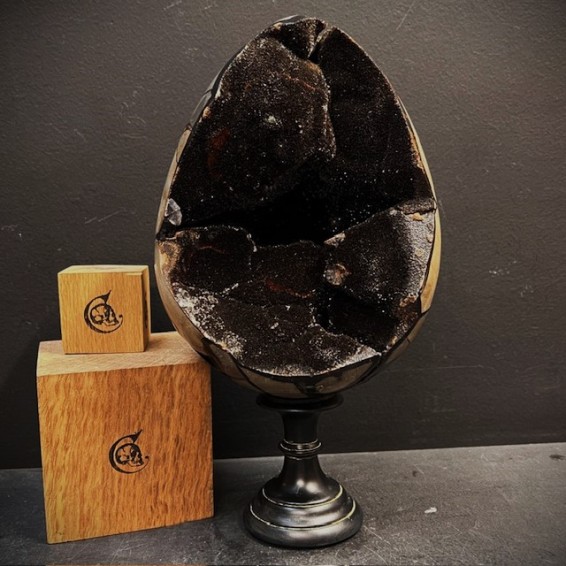
Display for ball or ostrich egg (Large)
High base specially designed to hold a ball or egg
Perfect for ostrich eggs
Not suitable for emu, rhea or swan eggs, for example











Dragon Stone
Septaria egg of Madagascar
Septaria Madagascar egg
Also known as Dragon Stone
Septaria is a stone composed of a mixture of yellow calcite and sandstone, found mainly on the island of Madagascar, characterized by highly visible shrinkage cracks. These highly visible cracks, known as Septa, fill with minerals over time.
When the stone is polished, these cracks stand out, giving it a dragon's egg appearance on the outside.
With time, tectonic movements, etc., the nodules can be fractured and new mineral solutions can invade the shrinkage cracks, often calcite.
In our case, Septaria has been polished into an egg shape and the interior has been invaded by a very fine crystallization of calcite. Beautiful crystals.
It's also easy to see why it's called Dragon's Stone: the exterior is very similar to a dragon's egg!
Sold without base
Ref OSM55: Weight: 4.1kg - Height: 20cm
Sold without the base
You can find available bases by typing ball base or egg base in the site search.
High base specially designed to hold a ball or egg
Perfect for ostrich eggs
Not suitable for emu, rhea or swan eggs, for example
display for ball or egg (small)
Material: Resin material
Wooden base for ball or sphere - Base - support
Grey-Black patinated marble base for ball or sphere
Base - support
Steampunk Flight of butterflies Napeocles Jucunda et Salamis Parhassus
Herbalist's or Pharmacist's jar
Antique blank label of the XVIIIth century
Red chalk drawing- Anatomical drawing
Anatomical study
Drawn by Eugène de Montchoisy in Saint-Brieuc in November 1840
These are not reproductions but original period drawings in red chalk.
You are purchasing one plate, not the entire set of plates
Antique surgical board
From Benjamin Bell's Complete Course in Surgery, published in 1796
Antique bezoar - Antipoison - Antidote
Once sold by the apothecary, bezoar, also known as gallstone, was reputed to have the same anti-poison properties as the legendary unicorn's horn, hence its excessively high price, also due to its great rarity.
An important piece in a cabinet of curiosities
Sold alone - Without stand, sold separately
Atlas of descriptive anatomy of the human body
Anatomy board
By Doctors Bonamy and Paul Broca
Draftsman: Emile BEAU
Published on July 1st 1854
Large Naturalist Magnifier
Species: Morpho Didius butterfly of Peru
Ex-Voto heart in clay by Cuore di Argilla
Italy crafts
A contemporary reinterpretation of the traditional ex-voto, originally a votive offering made to a god in request of a grace or in thanks for a grace obtained after a vow.
Memento Mori sculpted from a deck of cards - Poker
Size M
RED color
Antique study mask by Simonne Laubé, circa 1930
Flayed model
In vulcanized and painted rubber
Inspired by the famous death mask from L'Inconnue de la Seine
Entomological box
Species: Papilio Bromus butterfly
Pick-up in store in Paris only
Madagascar sawyer ammonite - Cleoniceras fern ammonite
Cleoniceras fern ammonite
100 million year old fossil
Anatomical chart by Ludovic Hirschfeld drawn by Léveillé
From Traité et iconographie du système nerveux et des organes des sens de l'homme avec leur mode de préparation
Published in 1866
Lithography
You buy 1 plate, not the whole set
Megalodon tooth fossil - Otodus megalodon
11.8cm
Indonesia
Fossil shark tooth
Human skull - Replica by artist Jérôme Cavailles
Ref: Août 19

Dragon Stone
Septaria egg of Madagascar










